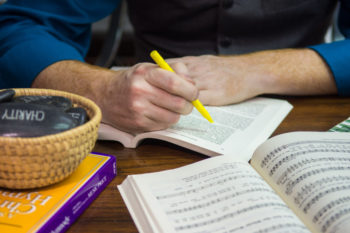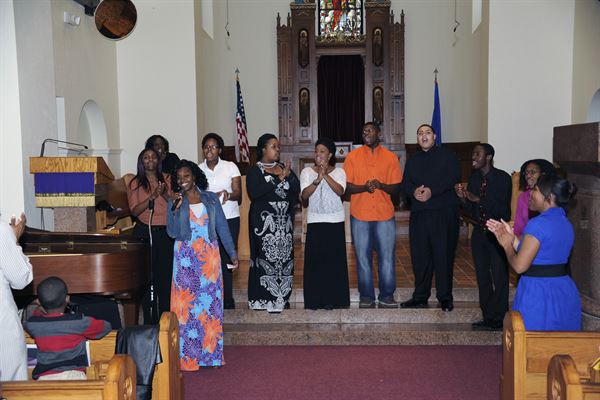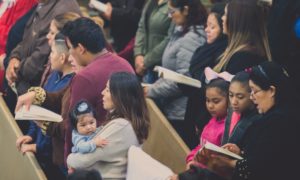I am a music teacher and music therapist by training, as well as a church choir director. However, in March of 2020 I found myself with no choir, as I’m sure many of you did as well.
My husband, Rich, is the pastor of the United Methodist Church of Anacortes (Washington), where, pre-COVID, I directed the choir. He suggested finding ways to keep people singing. I understood the value of breathing to calm nerves, in addition to supporting singing. I knew the muscles used for singing can quickly atrophy—a weakness I was already recognizing in myself at that time. I also knew that music can provide strength and consolation during hard times. Though he’d used the word “hymn sing”, Rich indicated that phrase didn’t quite capture his hopes. After mulling over ideas, in mid-July 2020 we had the first Zoom meeting of Musical Connections, a name I felt captured my aims: to encourage people to keep singing and making music during challenging times, and to provide an opportunity for them to connect with one another in supportive dialogue.
Before beginning the sessions, I drew up a lengthy list of themes. These ideas served to create cohesive sessions as well as to provide opportunities for participants to offer suggestions. My confidence also increased as I saw multiple possibilities. Some of the original themes I worked with were: songs of comfort, strength, hope; children’s songs–those that created a foundation for us; songs which touch on nautical ideas since we are a seaside town; spirituals; songs which allude to light or vision; songs inspired from nature. A recurring “theme” since summer 2021 has been to examine the hymns of writers or musicians whose names appear often in our hymnals or supplements. We had more participants than usual for our 2021 Christmas caroling session, as we quickly responded to impromptu requests. This involved finding then sharing the appropriate video in our now extensive video collection, which includes videos created by various singers in our congregation.
As we began our Zoom sessions we quickly realized that we needed to “up” our technological game. We first tried simply sharing lyrics on the Zoom screen and live acapella singing to lead participants, then did some recording with an inexpensive video camera. Within a couple weeks we began recording songs with my iPad, which we are still doing 2 years later. We added an external microphone not long after beginning use of the iPad. This mic, made by Shure, made a huge difference in the quality of our recordings, helping us to capture a better balance between the singing and accompaniment (piano, guitar, ukulele, or drum). Perhaps the best resource is someone who can understand technology, your needs, and can make good suggestions. My husband worked with Sweetwater, a company based in Fort Wayne, Indiana, because their customer service is top-notch.
Concerning written musical resources, we have worked primarily with The United Methodist Hymnal. I also purchased the accompaniment version for the supplemental hymnal in the pews at our church. Recognizing resources from other traditions, we’ve used some older Methodist hymnals, an old Presbyterian hymnal, an Episcopal hymnal, and one called Hymns for the Living Church. A few hymns we found online, some of which were free and some that required payment.
By late fall of 2020, as I offered more background information on hymn origins, our Musical Connections group recognized that some hymns were birthed in situations when faith was deeply tried. The most well-known story is probably that of Horatio Spafford, who penned the lyrics for “It Is Well with My Soul” when he was taken to the site where his daughters had perished when the ship they were on sank. Given the myriad difficulties our world was facing, I thought (in good music therapist fashion) that we could write a hymn to create an outlet for emotions and to keep a Christ-centered perspective. In music therapy work, songwriting often takes place in less than 30 minutes, usually setting the lyrics or collected ideas to a pre-existing melody. I was probably more surprised than anyone else when we gathered our ideas over several sessions and designated a poet from our group to craft our ideas into a hymn. Sara did a beautiful job, and then I was challenged to write music to enhance the lyrics. You never know where the road will lead when you set out!
As I write this, in winter 2022, we are still meeting via Zoom for an hour every Wednesday morning, with a usual pattern of singing and discussing 4 hymns. We are not usually a large group, typically hosting from 9 to 15 participants, but we are singing! May God bless you as you find ways to keep singing, wherever you are and whatever your situation.
Feel free to contact me if you have any questions: mp.feagin@gmail.com.
You are welcome to join us for one of our Musical Connections sessions if you’d like.
Mary Penhorwood Feagin
United Methodist Church of Anacortes
Anacortes, Washington


 If I were to purchase a simple liturgical music library for you…a “small-church music starter kit,” here’s what I would send you:
If I were to purchase a simple liturgical music library for you…a “small-church music starter kit,” here’s what I would send you: Small choir resources are tough, especially when people are still working off the old model of “we used to be…”. I think this is where placing the congregation’s voice as #1 is really helpful. It changes the choir’s “job” from singing a solo anthem every week to supporting the congregation’s music-making. I think we do a disservice to ourselves, our choir members, and our congregation to expect a small volunteer group of singers to sing a published anthem every week with enough musicality and precision that it truly edifies the congregation and singers. But, if we re-frame the choir’s role as supporting the congregation, here’s what can happen:
Small choir resources are tough, especially when people are still working off the old model of “we used to be…”. I think this is where placing the congregation’s voice as #1 is really helpful. It changes the choir’s “job” from singing a solo anthem every week to supporting the congregation’s music-making. I think we do a disservice to ourselves, our choir members, and our congregation to expect a small volunteer group of singers to sing a published anthem every week with enough musicality and precision that it truly edifies the congregation and singers. But, if we re-frame the choir’s role as supporting the congregation, here’s what can happen:
 job that involves working at the school affiliated with my church. I have to say, I’d forgotten how much having children around makes each holiday feel so special. Children have an enthusiasm for celebrations and traditions that is infectious to the rest of us. Easter Sunday may not be a good time for the children’s choir to sing, but it’s perfectly appropriate to have them sing an Easter song on the Sunday(s) after Easter. Small children delight in having songs to sing that go with whatever season it is, so even if you’re working with children in a less formal setting than a choir, you can keep singing your resurrection songs all through the season. (Sidebar: I’ve found there aren’t enough Easter songs to satisfy the appetites of young children. Which Easter songs do your children love?) You might find that you have more opportunity to discuss the true meaning of Easter with the children once the Easter bunny has faded away, too.
job that involves working at the school affiliated with my church. I have to say, I’d forgotten how much having children around makes each holiday feel so special. Children have an enthusiasm for celebrations and traditions that is infectious to the rest of us. Easter Sunday may not be a good time for the children’s choir to sing, but it’s perfectly appropriate to have them sing an Easter song on the Sunday(s) after Easter. Small children delight in having songs to sing that go with whatever season it is, so even if you’re working with children in a less formal setting than a choir, you can keep singing your resurrection songs all through the season. (Sidebar: I’ve found there aren’t enough Easter songs to satisfy the appetites of young children. Which Easter songs do your children love?) You might find that you have more opportunity to discuss the true meaning of Easter with the children once the Easter bunny has faded away, too.